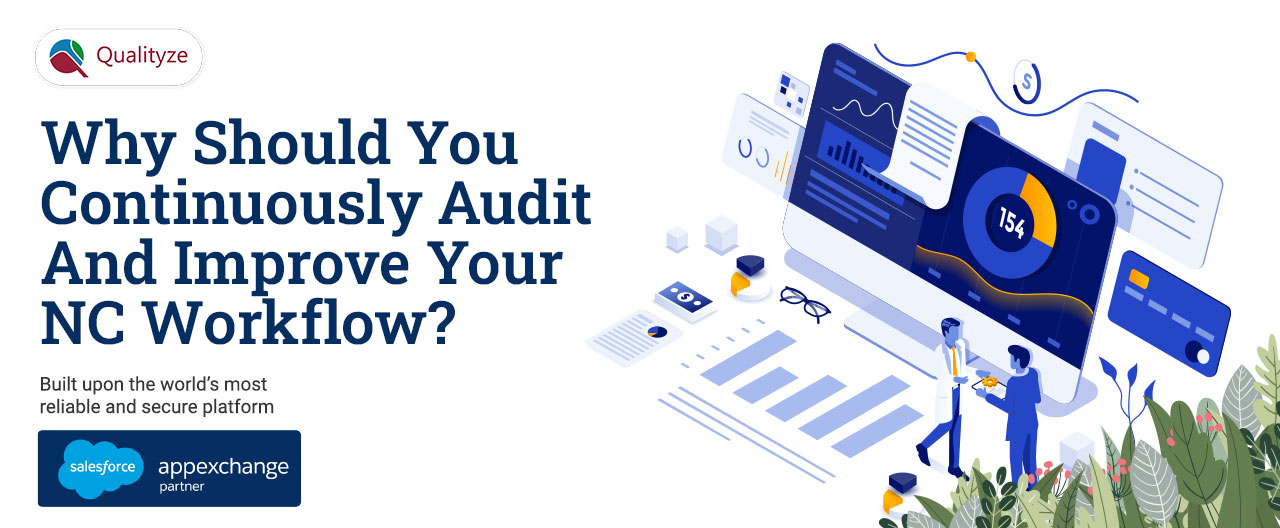Calculate your potential savings with our ROI Calculator
ROI CalculatorCalculate your potential savings with our ROI Calculator
ROI Calculator
Perhaps you noticed that the production team was not meeting their deadlines. Our customer complaints have been on the rise for quite some time. No matter how you slice it, something is not right about how your organization works. As a result, your teams may have to rework, experience adverse events or incidents, or even encounter friction with one another. When this happens, you should conduct a nonconformance workflow audit.
Before we move on to the audit, it would be best to clarify what we are discussing.
Nonconformance workflows (NC workflows) provide a roadmap for resolving quality issues. NC workflows are critical to reporting and managing quality issues in your day-to-day work, regardless of your department. Each step, from reporting the nonconformances to investigating and resolving them, is included in this process. Team leads, quality managers, and department heads may be aware of the NC workflows involving their teams, but they might not have the right tools and training to audit and improve NC workflows.
When NC workflows run smoothly, you barely notice them. Instead, it lets you focus on getting the job done, hitting deadlines, and working with the people you enjoy.
However, when your workflows go out of order, you definitely notice. It can affect your relationships with coworkers, lengthen your workday, clog up your inbox, and more. These are a few signs that your NC workflow needs improvement:
Quick Read: Audit Analysis: Know Why It is Important?
Before we head on to understand the process of performing a workflow audit, we must understand the fact that audits highlight the inconsistencies and gaps in the process. The process of auditing is focused on identifying the problems what needs to be addressed rather than blaming departments and teams.
We have already discussed the warning signs that trigger the need for an audit of NC workflows. So, what are the next steps?
We have you covered! Here is a step-by-step guide to auditing your NC workflow:
“What does it take to turn an idea on a paper into a success milestone?” Consider all the steps involved, from big kickoff meetings to emails sent individually. Does the process require approval at any point? How do you identify critical stakeholders? Communication channels that should be used? Do you use any specific tools? When mapping your workflow, ask yourself these questions. Identify the answers, then illustrate your workflow.
You might already know where hiccups or blocked processes are happening now that you have seen your workflow in visual form. For example, how long does it take for a particular individual to approve a workflow task? If this is the case, you have already identified an area to improve. Which channels do you use for communication? Are you afraid when you see “trace an NC record from a particular time frame”? You will notice these issues more quickly if you work with this workflow daily.
Related Article: What’s the Purpose of Maintaining Nonconformance Records?
The inefficiency of bottlenecks slows down workflows. However, you should not limit your attention to these places alone. Look for ways to improve work beyond the places where it slows down. The approval process might be redundant if it involves multiple stakeholders, so reducing it to only one might be more effective. Discuss with your team whether acquiring nonconformance reporting and management software would improve parts of your workflow. Your team may have ideas you had not considered; do not be afraid to ask them for their input.
It is time to smooth out the rough spots in your workflow. Perhaps you can use a Nonconformance Management Solution like Qualityze to create a closed loop system for addressing issues. By mapping out your workflow, you can streamline the processes using the platform. You can simplify your team’s work by rearranging their responsibilities. The best way to implement a change is usually one at a time. Getting better feedback is easier and faster with this approach. Having that feedback when you are ready to make a decision is crucial.
You have changed your workflow a lot. For example, a new tool may have replaced printed documents in your team’s workflow or eliminated their reliance on printed copies. Unfortunately, the change is made or adopted; the workflow audit process does not end. Instead, observe how it has impacted your life. You want to know how many hours and dollars your company has saved through the change and a mixture of qualitative and quantitative data. Have things gotten better? Is it much smoother now? Following a successful transition, you can continue to the following strategy variation and repeat the cycle until your NC workflow is optimized.
These steps are likely to make it easier for you to audit your NC workflow and make the necessary improvements. You can manage them even more efficiently by using the right Audit Management Software.
With effective audit management software like Qualityze, you can identify the areas of improvement in every workflow including NC. It eliminates all the administrative load that you experience with paper-based systems or the aging technology solutions.
Qualityze Audit Management solution is built on the most powerful, secure, and reliable platform, i.e., Salesforce.com. It seamlessly integrates with the nonconformance management solution and other enterprise level quality systems to give you better control of improvement opportunities.
Would you like to experience the Qualityze difference?
Request a free demo right now.
Alternatively, contact our customer success team for more queries about Qualityze smarter quality solutions. You can reach us at info@qualityze.com, or you can give us a call on 1-877-207-8616, and our team will get back to you at the earliest.